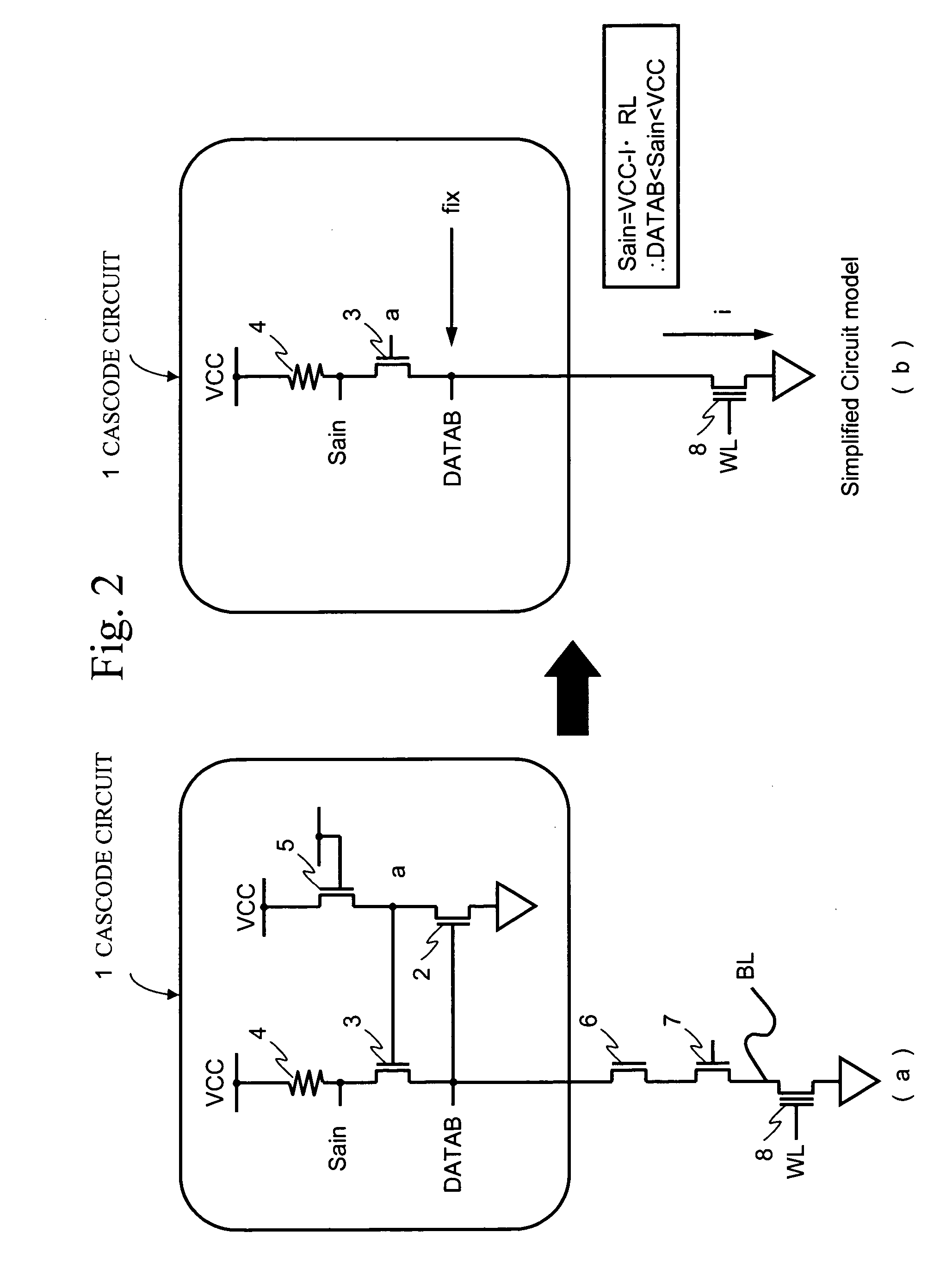Semiconductor device and method of generating sense signal
a technology of sensing signal and semiconductor device, which is applied in the direction of static storage, digital storage, instruments, etc., can solve the problems of limitation on the reduction of data line voltage datab, difficulty in raising power supply voltage vcc, etc., and achieves the effect of easy circuit matching and low power supply voltag
- Summary
- Abstract
- Description
- Claims
- Application Information
AI Technical Summary
Benefits of technology
Problems solved by technology
Method used
Image
Examples
first embodiment
[0040]FIG. 3 shows a semiconductor device according to a first embodiment of the present invention. A semiconductor device 10 includes a cascode circuit (SAR) 20 for a reference cell, a plurality of cascode circuits (CAS) 30 for core cells, and a plurality of sense amplifiers (S / A) 40. The semiconductor device 10 may be a semiconductor memory device solely packaged like a flash memory, or may be incorporated into a semiconductor device as a part therein, such as a system LSI.
[0041]FIG. 3 shows a circuit configuration for reading an SLC (Single Level Cell). In SLC, cell data is read with the single reference cell. Thus, the cascode circuit 20 for the reference cell is prepared. The reference cell is connected to the drain terminal of the reference cell through a data line DATABref. The cascode circuit 20 for the reference cell generates a reference voltage Saref and an NMOS gate voltage NG.
[0042] Further, 16 cascode circuits 30 for core cells are provided and connected, via data li...
second embodiment
[0052] Now, a second embodiment will be described. FIG. 6 shows a relationship between the core cell current and the reference current in reading an MLC (two bits / cell). The MLC is configured so that the memory cell has different threshold values. In FIG. 6, the horizontal axis denotes the gate voltage (threshold value for the distribution of threshold values), and the vertical axis denotes the drain current (the degree of distribution for the distribution of threshold values). The threshold values of the cell define two bits and fall in any of states “0”, “1”, “2” and “3”.
[0053] By way of example, a case is considered where a core cell having a threshold value of LEVEL1 is selected and read. A word line WL voltage used at the time of reading is applied to the gate electrodes of three reference cells ref(2:0) and the selected core cell. The word line voltage is set at a level at which little current flows through a core cell having a threshold value of LEVEL3. At that time, the cel...
third embodiment
[0065] The third embodiment of the present invention will now be described. When it takes a long time to charge the data line DATAB, a current for charging the data line flows the PMOS transistors of the PMOS current mirror in addition to the current of the cell selected during the sense period. This reduces the margin for sensing of the cells through which the currents do not flow. The cascode circuit employed in the third embodiment shown in FIG. 9 is designed to avoid the above problem.
[0066]FIG. 9 shows the cascode circuit for the core cell employed in the third embodiment. A core cell cascode circuit 230 includes transistors 233 and 234, a PMOS current mirror, resistors 237 through 239, a PMOS transistor 240, an NMOS transistor 241, and an inverter 242. The transistors 233 and 234 are cascode-connected to a data line 231 of the core cell. The PMOS current mirror is composed of PMOS transistors 235 and 236. The PMOS transistor 240, the NMOS transistor 241 and the inverter 242 f...
PUM
 Login to View More
Login to View More Abstract
Description
Claims
Application Information
 Login to View More
Login to View More - R&D
- Intellectual Property
- Life Sciences
- Materials
- Tech Scout
- Unparalleled Data Quality
- Higher Quality Content
- 60% Fewer Hallucinations
Browse by: Latest US Patents, China's latest patents, Technical Efficacy Thesaurus, Application Domain, Technology Topic, Popular Technical Reports.
© 2025 PatSnap. All rights reserved.Legal|Privacy policy|Modern Slavery Act Transparency Statement|Sitemap|About US| Contact US: help@patsnap.com



